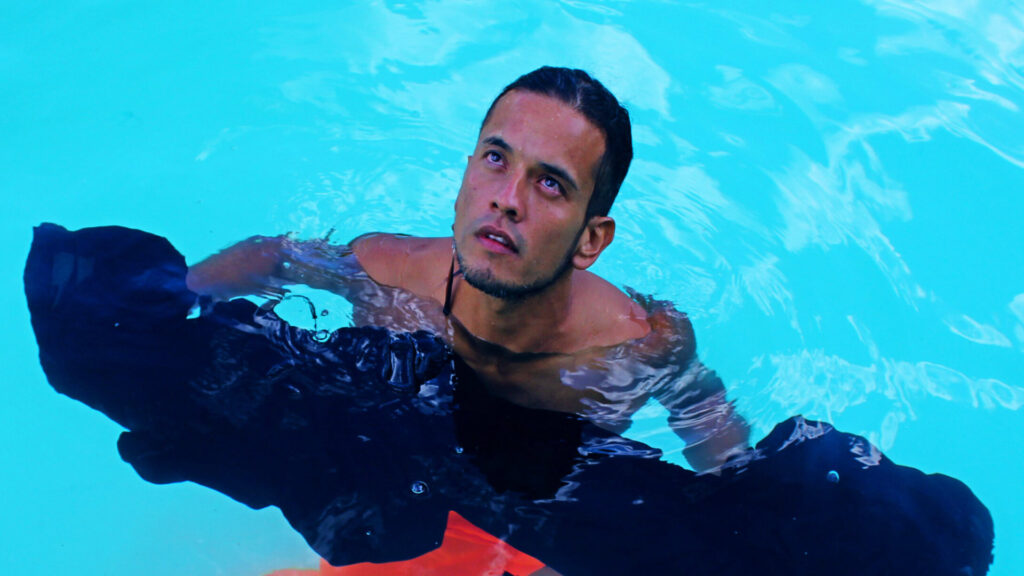“You give it a ritual; you make the foundation ritualistic and that makes it more special. And the music, it says ‘OK, we have a deal that we have this moment, this time, and there you can truly release something.”
When was the last time you went to a show and genuinely felt like a different person walked out than the one who walked in? What if there was an artist that, through their live show, audiences experienced collective transformation through ritualistic intention? A combination of light, sound, space, emotion, and physicality that when combined in a certain way allows a direct and uninterrupted communication between the artist and the audience by speaking to all the senses at once. Then you mustn’t have been to a Fotocopia show lately.
Underground music circles in Europe have been buzzing about the Galician-born, Valencia-based artist whose fusion of EBM and hardcore punk has been making waves at DIY venues and boutique festivals for its explosive live format. I had the opportunity to meet with Teo Cid González, the force behind Fotocopia, and interview them for Public Pressure at their studio in Alboraya.
Teo laughs, “It happens with me that people start to scream, you know, and they don’t know the songs. Then you see somebody, and they start screaming like, “Aah!” But having fun, you know, and to me I think, ‘Oh, fuck, this is so cool.’ In some gigs I give them the mic and people just scream and it gets, like, crazy. And that’s cool because that should be liberating too. That’s part of why I do it, because I feel so good doing that because it’s like, ‘Aah!’ Yeah!”
Prior to starting Fotocopia, Teo cut their teeth playing guitar for bands in the noise and punk scenes. When they started to experiment with electronic music it was only natural to incorporate this DNA into their live show, where audiences witness antics one would expect from an act like The Dillinger Escape Plan. Often, you’ll find Teo set up on the floor with the crowd, avoiding the stage where possible, allowing the audience to circle him for an immersive and intimate experience. “I do it because in the past playing with my bands many places in the hardcore scene are really small and there is no stage. Normally this is the position, like audience and the band is the same. It’s like they are equal, you know.”
In fact Teo feels even less comfortable up on stage by himself, referring to DJ booths as “like a jail”, and ensuring that when required to perform on a stage that the table for his equipment is perpendicular to the crowd so that it does not create a barrier between them. If the venue doesn’t allow the equipment to be set up on the floor with the audience, you can be sure Teo will end up amongst the crowd anyway. “It doesn’t matter because if there is a barrier, I break it, and that’s impactful, you know.”
As the sound of pounding kick drums and tense bass fills your ears, Teo moves purposefully and antagonistically through a thick haze of smoke, lunging rhythmically, jumping up and down to the groove, and throwing fists towards the crowd as their vision is augmented by heavy strobes and directional flashes of light. Audiences are left wondering if a message is being expressed to them, or if they are being met with a provocation in order to elicit a reaction.
“Both. It’s both those things,” smiles Teo, “because I want to express, but until one point, you know. I don’t want to hurt anyone, and this is hard because for me, it’s interesting to create the tension but not in a harmful way. The feeling of danger is there, but it’s a fiction. You know what I mean? In the hardcore punk scene, maybe you are 15 years old, and you’re there, and it’s like, wow, like something is flying over your head, a guy is like jumping, and it’s exciting to be there.”
This makes even more sense when you meet Teo in person, as their demeanour is warm, friendly and deeply introspective, starkly contrasting to the persona they inhabit while performing. While there is clearly an aggression in the music of Fotocopia, according to Teo anger for the sake of anger is only cool for a while. “I’m not a negative person,” says Teo. “I think you can transform anger and in fact, music is cool because of that, because you can, release things out and do something there with all the people, something more ritualistic.”
“When you ask me which emotions drive me to play or to make the music, I guess it’s that. It’s weird because of many things, you know. I want to communicate – but communication that is absent of interferences, like this. we are having this conversation that is getting deeper because we decided it’s going to be an interview about my art.”
The circumstances must be curated in order to open this channel of energy between people, and one of the ways Teo achieves this is with his lighting design, which they engineer themselves using Arduino components. Lighting is usually approached in a two-dimensional way, mounted vertically so that people see them at eye level, but at a Fotocopia show the utilisation of space by shying away from traditional spaces, allows for lights to be incorporated in a way that adds a third dimension to the experience. “I’m playing the trick of lights. Because in some ways it’s a trick and I feel like I’m cheating people with lights” says Teo, referring to the placement of LED lights on the floor to give the impression that light is coming from nowhere.
“But yet we use it like another instrument; maybe the light goes with the snare, but in the next verse it goes with the kick, and it makes some change in the atmosphere. One day I put a light in a trash bin that was in the venue, so the trash bin was-”
Teo makes an impression of light exploding from a trash can.
“- but you know, you can do a lot of things just with the space.”
This DIY approach is physically minimalistic and changes the atmosphere of a small venue in a big way. It’s also capable of transforming the atmosphere of a big venue in an aesthetically minimal way. “It’s cool because I don’t need to have so much respect for them you know, I can take them and destroy them because I can fix it.”
While easy to carry, they do raise eyebrows when clearing security.
“At the airport they are like, ‘what the fuck is that?!’ You know, in a plane or something that looks like a bomb because you have like 10 meters of cable and it’s like “What the fuck?!””
See Teo performing as Fotocopia live
Cover photo by Cristian Bertolo
Next story


